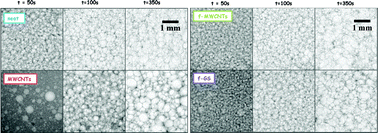Effect of carbon nanofillers on flexible polyurethane foaming from a chemical and physical perspective
Abstract
The effect of carbon nanoparticles (CNPs) on the physical and chemical events taking place during the foaming evolution of flexible polyurethane (FPU) foams is analysed by in situ X-ray time-resolved imaging. The differences observed in the cellular structure and density evolution of nanocomposite foams are explained in terms of the type of nanoparticles and the functional groups on their surface. The presence of certain types of particles enhanced the bubble nucleation at the beginning of the process although some others did not. The chemical interaction seems to produce delays in the blowing reaction process and promotes coalescence events during foam evolution as regarding the cell density results obtained. This study on the kinetics of polymerisation and morphology development of reactive PU nanocomposite foams contributes to understanding the physical phenomena occurring as a consequence of the CNP–FPU chemical interaction.


 Please wait while we load your content...
Please wait while we load your content...